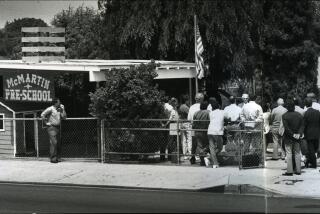McMartin Pre-School
- Share via
In response to David Shaw’s news analysis of the McMartin Pre-School case, Part A, Jan. 19-22:
Here’s the bias I see in Shaw’s stuff: His critiques are built on the premise that the kids’ claims were manufactured and that, therefore, any reporter who was “skeptical” about their charges should get kudos.
Me, I always figured it was for the judicial system--not reporters--to decide how skeptical or believing to be about the children’s allegations.
Shaw (with little skepticism) bought the defense attorneys’ line that my reporting was “pro-prosecution.” And he had a terrific opportunity to find evidence of such a slant if it existed, because Shaw accepted my invitation to watch all of the Channel 7 coverage, which we did together for 16 hours. And still he couldn’t find solid evidence of a tilt. Undeterred, Shaw went on to stitch together the oddest mosaic to buttress his preconception: Reporter Satz used words like “bizarre” to describe the allegations; he had a funny pronunciation of the phrase “lit-tle children”; he characterized one of Virginia McMartin’s off-point ramblings as “disingenuous”; he juxtaposed a defendant’s denial with the grand jury’s accusation against her; he allegedly used a nasty tone of voice with a DA who jumped ship; he was on the air with stories almost “daily.” Shaw’s case is, um, a lit-tle thin.
To his credit, he manages to acknowledge that our coverage included, for example, more denials and rebuttals from those accused than “ any other media working the story.” Can we dwell on that for a second? We’re talking about an international story here, covered intensively by scores of reporters and editors for years. Could it possibly be that the one news outfit that went furthest in giving the defendants a forum in which to state their case is the very same one accused of triggering a pro-prosecution frenzy?! Yes, Shaw admits it. But it’s buried in the story, because it’s at odds with his thesis.
His thesis poses this question: Since the charges were phony, why didn’t reporters figure that out sooner? He’s entitled to his biases; none of us is “objective.” The more troubling thing was his subtle distortion of our very first story on McMartin.
That first broadcast was worded quite carefully, so that viewers would know that a significant number of children were making allegations, and that authorities were taking the allegations seriously, but that the TV station took no position. The story that broke things open said that more than 60 kids “have now each told authorities that he or she had been keeping a grotesque secret.” Indeed, that was what children were claiming. But by careless quoting, Shaw makes it sound as if I went on the air and announced: Folks, I’m here to tell you that kids are revealing grotesque secrets. No, no David; they say they are revealing secrets. Leaving out the qualifiers gives the impression that I had personally concluded that the kids actually had “secrets” to reveal, and that, furthermore, I had judged these secrets to be “grotesque.” To speak that way would be to assume the defendants were guilty and it’s a mistake we never made; we always characterized what children said as allegations--and not as proven facts. Conveniently, Shaw’s rewrite supports the belief that that Frenzy-Triggering-TV-Newsman went on the air and declared that the children were molestation victims--with “grotesque secrets” to disclose.
When I pointed out this mistake to Shaw, he replied: “I don’t see the difference.” Well, there’s the problem. Shaw makes very public judgments about the work of his fellow reporters, but he’s got this blind spot about the most basic dichotomy in journalism--the difference between an allegation and a fact.
WAYNE SATZ
Studio City
Satz broke the McMartin story Feb. 2, 1984, on KABC-TV.
More to Read
Sign up for Essential California
The most important California stories and recommendations in your inbox every morning.
You may occasionally receive promotional content from the Los Angeles Times.













